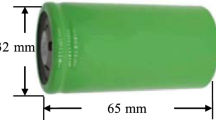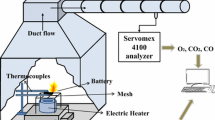Abstract
In order to explore the thermal safety of lithium ion batteries (LIBs), a series of thermal runaway tests for single 32,650 LIB with different state of charges (SOC) and double 32,650 LIBs with different spacings from 0 to 2 D (D is 32 mm) are conducted in this work. It is clearly shown that the increasing SOC decreases the onset and duration time of the jet fire stages, increasing the mass loss and flame area in the jet fire stages. With the spacing decreases, the thermal effect of the flames on the LIBs is enhanced, which decreases the onset and duration time of the jet fire stages, increasing the mass loss and strengthening the combustion in the two second jet fire stages. In addition, according to the flame surface area and mass loss rate (MLR), the heat of combustion of LIB is estimated as \(\Delta H_{{\text{c}}} = 8.21\;{\text{kJ}}\,\text{g}^{-1}\), and a simplified model is derived to predict the heat release rate (HRR) of LIBs. The above results provide a theoretical foundation for quantitative assessment of the fire risk of the LIBs.












Similar content being viewed by others
Abbreviations
- LIB:
-
Lithium ion battery
- SOC:
-
State of charge
- HRR:
-
Heat release rate
- MLR:
-
Mass loss rate
- ISO:
-
International organization for standardization
- H:
-
Battery sample height (mm)
- \(\Delta H_{{\text{c}}}\) :
-
Heat of combustion (kJ g−1)
- \(S\) :
-
Flame surface area (m2)
- \(d\) :
-
Flame width (m)
- \(h\) :
-
Flame height (m)
- \(L\) :
-
Cone bevel length (m)
- \(\dot{q}\) :
-
Heat release rate (kJ s−1)
- \(k\) :
-
Heat release rate of unit flame surface (kW m−2)
- \(\chi\) :
-
Combustion efficiency
- \(\dot{m}\) :
-
Mass loss rate (kg s−1)
- \(\overline{{{\text{HRR}}}}\) :
-
Average heat release rate (kJ s−1)
- \({\text{HRR}}_{\max }\) :
-
Maximum heat release rate (kJ s−1)
References
Wang QS, Mao BB, Stoliarov SI, Sun JH. A review of lithium ion battery failure mechanisms and fire prevention strategies. Prog Energ Combust. 2019;73:95–131.
Maleki H, Deng G, Anani A, Howard J. Thermal stability studies of Li-Ion cells and components. J Electrochem Soc. 1999;146(9):3224–9.
Golubkov AW, Fuchs D, Wagner J, Wiltsche H, Stangl C, Fauler G, Voitic G, Thaler A, Hacker V. Thermal-runaway experiments on consumer Li-ion batteries with metal-oxide and olivin-type cathodes. Rsc Adv. 2014;4(7):3633–42.
Chen MY, Liu JH, Ouyang DX, Wang J. Experimental investigation on the effect of ambient pressure on thermal runaway and fire behaviors of lithium-ion batteries. Int J Energ Res. 2019;43(9):4898–911.
Kong D, Wang G, Ping P, Wen J. A coupled conjugate heat transfer and CFD model for the thermal runaway evolution and jet fire of 18650 lithium-ion battery under thermal abuse. eTransportation 12 (2022) 100157.
Wang Z, Ouyang DX, Chen MY, Wang XH, Zhang Z, Wang J. Fire behavior of lithium-ion battery with different states of charge induced by high incident heat fluxes. J Therm Anal Calorim. 2019;136(6):2239–47.
Larsson F, Mellander B-E. Abuse by external heating. Overcharge and short circuiting of commercial Lithium-Ion battery cells. J Electrochem Soc. 2014;161(10):A1611–7.
Ping P, Wang QS, Huang PF, Li K, Sun JH, Kong DP, Chen CH. Study of the fire behavior of high-energy lithium-ion batteries with full-scale burning test. J Power Sources. 2015;285:80–9.
Lopez C, Jeevarajan J, Mukherjee P. Experimental analysis of thermal runaway and propagation in Lithium-Ion battery modules. J Electrochem Soc. 2015;162:A1905–15.
Abdelsalam S, Zaher A. On behavioral response of ciliated cervical canal on the development of electroosmotic forces in spermatic fluid. Math Model Nat Phenomena 17 (2022).
Abdelsalam SI, Mekheimer KS, Zaher AZ. Dynamism of a hybrid Casson nanofluid with laser radiation and chemical reaction through sinusoidal channels, Wave Random Complex (2022), 1–22.
Alsharif AM, Abdellateef AI, Elmaboud YA, Abdelsalam SI. Performance enhancement of a DC-operated micropump with electroosmosis in a hybrid nanofluid: fractional Cattaneo heat flux problem. Appl Math Mech English Edn. 2022;43(6):931–44.
M.M. Bhatti, O.A. Beg, S.I. Abdelsalam, Computational Framework of Magnetized MgO-Ni/Water-Based Stagnation Nanoflow Past an Elastic Stretching Surface: Application in Solar Energy Coatings, NANOMATERIALS 12(7) (2022).
Sridhar V, Ramesh K, Gnaneswara Reddy M, Azese MN, Abdelsalam SI On the entropy optimization of hemodynamic peristaltic pumping of a nanofluid with geometry effects. Wave Random Complex (2022), pp 1–21.
Thumma T, Mishra SR, Abbas MA, Bhatti MM, Abdelsalam SI. Three-dimensional nanofluid stirring with non-uniform heat source/sink through an elongated sheet. Appl Math Comput. 2022, 421.
Chen MY, Ouyang DX, Liu JH, Wang J. Investigation on thermal and fire propagation behaviors of multiple lithium-ion batteries within the package. Appl Thermal Eng. 2019, 157.
Wang ZR, Mao N, Jiang FW. Study on the effect of spacing on thermal runaway propagation for lithium-ion batteries. J Therm Anal Calorim. 2020;140(6):2849–63.
Sturk D, Hoffmann L, Tidblad AA. Fire tests on E-vehicle battery cells and packs. Traffic Inj Prev. 2015;16:S159–64.
Wang QS, Huang PF, Ping P, Du YL, Li K, Sun JH. Combustion behavior of lithium iron phosphate battery induced by external heat radiation. J Loss Prevent Proc. 2017;49:961–9.
Orloff L, De Ris J. Froude modeling of pool fires. Symposium (International) Combust. 1982, 19(1):885–95.
Grossel SS. Evaluation of fire safety. J Loss Prevent Proc. 2006;19(4):372–3.
Linteris GT, Rafferty I. Scale Model Flames for Determining the Heat Release Rate from Burning Polymers. In: Saito K, editor. Progress in Scale Modeling: Summary of the First International Symposium on Scale Modeling (ISSM I in 1988) and Selected Papers from Subsequent Symposia (ISSM II in 1997 through ISSM V in 2006). Netherlands, Dordrecht: Springer; 2008. p. 235–45.
Linteris GT, Rafferty IP. Flame size, heat release, and smoke points in materials flammability. Fire Safety J. 2008;43(6):442–50.
Yan WG, Wang CJ, Guo J. One Extended OTSU Flame Image Recognition Method Using RGBL and Stripe Segmentation. Appl Mech Mater. 2012;121–126:2141–5.
Chen H, Buston JEH, Gill J, Howard D, Williams RCE, Rao Vendra CM, Shelke A, Wen JX. An experimental study on thermal runaway characteristics of lithium-ion batteries with high specific energy and prediction of heat release rate. J Power Sources. 2020, 472:228585.
Brownlie AR. Into the Flames: An introduction to fire dynamics. J Institute Telev Eng Japan. 1985, 41(5).
Eshetu GG, Grugeon S, Laruelle S, Boyanov S, Lecocq A, Bertrand J-P, Marlair G. In-depth safety-focused analysis of solvents used in electrolytes for large scale lithium ion batteries. Phys Chem Chem Phys. 2013;15(23):9145–55.
Fu YY, Lu S, Li KY, Liu CC, Cheng XD, Zhang HP. An experimental study on burning behaviors of 18650 lithium ion batteries using a cone calorimeter. J Power Sources. 2015;273:216–22.
Mikolajczak C, Kahn M, White K, Long RT. Lithium-Ion fire hazard assessment. In: Mikolajczak C, Kahn M, White K, Long RT, editors. Lithium-Ion Batteries Hazard and Use Assessment. US: Springer; 2011. p. 85–104.
Larsson F, Andersson P, Blomqvist P, Loren A, Mellander BE. Characteristics of lithium-ion batteries during fire tests. J Power Sources. 2014;271:414–20.
Liu X, Wu Z, Stoliarov SI, Denlinger M, Masias A, Snyder K. Heat release during thermally-induced failure of a lithium ion battery: Impact of cathode composition. Fire Safety J. 2016;85:10–22.
Acknowledgements
This research is supported by National Natural Science Foundation of China (No. 52204253, No.51974298), and the Fundamental Research Funds for the Central Universities (No. 2022QN1009, NO. 2021ZDPYYQ004).
Author information
Authors and Affiliations
Corresponding authors
Additional information
Publisher's Note
Springer Nature remains neutral with regard to jurisdictional claims in published maps and institutional affiliations.
Rights and permissions
Springer Nature or its licensor (e.g. a society or other partner) holds exclusive rights to this article under a publishing agreement with the author(s) or other rightsholder(s); author self-archiving of the accepted manuscript version of this article is solely governed by the terms of such publishing agreement and applicable law.
About this article
Cite this article
An, W., Lu, Y., Liu, F. et al. Prediction of heat release rate of single/double 32,650 lithium ion batteries. J Therm Anal Calorim 148, 2057–2067 (2023). https://doi.org/10.1007/s10973-022-11766-x
Received:
Accepted:
Published:
Issue Date:
DOI: https://doi.org/10.1007/s10973-022-11766-x




